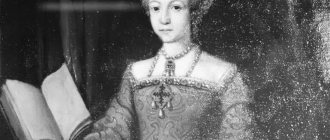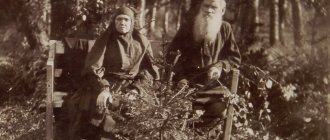It is better to suffer an offense than to inflict it.
Plato
Prince Yaroslav the Wise was born in 978. His father was Prince Vladimir, who placed his young son on the princely throne of the city of Novgorod, which he ruled until 1019. After the death of Prince Vladimir, the Kiev throne was seized by Svyatopolk, who, blinded by the thirst for power, killed his three brothers: Boris, Gleb and Svyatoslav. Wanting to punish his brother, Yaroslav gathers an army to march on Kyiv. In total, the army consisted of forty thousand Slavs and thousands of mercenary Varangians. This campaign began in 1016. The confrontation with Svyatopolk continued until 1019, and ended with the murder of the latter.
Biography
One of the most revered ancient Russian princes is Prince Yaroslav the Wise, the son of the great Vladimir Svyatoslavovich (the Baptist). He received the nickname “Wise” for his love of education and the creation of the first code of laws known in Rus', later called “Russian Truth”.
Prince Yaroslav the Wise
He is also the father, uncle and grandfather of many European rulers. At baptism, Yaroslav received the name George (or Yuri). The Russian Orthodox Church reveres him as a faithful believer and even included the day of his memory in the calendar. In a leap year it is March 4th, and in a normal year it is March 5th.
Alexander II abolished serfdom
Discussion: 17 comments
- Lena:
01.10.2008 at 00:00great information!
- Regina:
01/28/2009 at 00:00
The information is just great!!!!!!
- Natalia:
02/09/2009 at 00:00
Fascinating and interesting. Stimulates interest in Russian history. Written in accessible language.
- Anna:
03/09/2009 at 00:00
This report helped me a lot, thanks to Russian Idea.
- Alyona.:
03/12/2009 at 00:00
Very interesting information and this report helped me a lot.
- Elena:
08/15/2009 at 00:00
Thank you very much! I learned a lot of new things.
- Kate:
10/22/2009 at 00:00
Maybe I don’t understand something in history, but it’s quite interesting!!!
- Matvey:
11/19/2009 at 00:00
Very convenient thanks
- Ilya:
05/11/2010 at 00:00
cool!
- Victor Borkovsky, hereditary titled nobleman:
02.09.2010 at 00:00
According to archival documents, I am a hereditary nobleman of the ancient Dunin-Borkovsky family with the coat of arms of the Swan. Ancestors, on the paternal side - the Danish nobleman Peter the Dane (Dunin), and on the maternal side - the daughter of the Grand Duke of Kyiv Svyatopolk II, and the daughter of the Byzantine Emperor Komnenos Varvara, Maria. All of them are Rurikovichs, named after the First Grand Duke of Kyiv Rurik, as the Sovereign of the Kyiv State. Rurik, like Peter, the founder of the Dunin family (Dunin-Borkovsky, Dunin-Raevsky...) came from Denmark. Thus, the Grand Duke of Kiev Yaroslav the Wise, as well as the baptist of Kievan Rus, Saint Vladimir, are my great-grandfathers. Considering the blood relationship, I can say that even today in the territory of Kievan Rus there is unrest in order to humiliate its indigenous people and to assist in the seizure of its territory by foreigners. Just read the last words: “The grateful Russian people honored the memory of their Grand Duke by calling him Wise.” The Grand Duke of Kyiv was called wise during his lifetime, when there was no Russian people, just as there was no Ukrainian people. There was a Russian people, who were separated by the unheard-of rumors of Yaroslav the Wise, who called pagans to the territory of Kievan Rus to fight Christianity. This anti-Christ invasion was called the Mongol-Tatar yoke. For this they were paid tribute, because the Tatars did not occupy the territory of Kievan Rus. Honor not only the memory of Yaroslav the Wise in order to be involved in the history of Kievan Rus, but also honor his instructions on preventing hostility between the peoples of Kievan Rus in order to intoxicate themselves with their own power through the blood and tears of civil strife. Descendant of the Grand Dukes of Kyiv Rurikovich.
- BUR - V. Borkovsky:
09/03/2010 at 00:00
I respect the Rurikovichs. But I didn’t understand what you wanted to say?
- Diana:
10/28/2010 at 00:00
Very interesting... Let's hope that tomorrow this will help...
- I:
09.12.2010 at 00:00
It is interesting!!!
- Lyuba:
01/24/2011 at 00:00
Class
- Irina.:
02/10/2011 at 00:00
“Yaroslav’s wife was Ingigerda (in baptism - Irina, in monasticism Anna: 1019-1050), the daughter of the Swedish king Olaf, who gave her the city of Aldeigaburg and all of Karelia as a dowry - since then she has become part of Rus'.” - this should be clarified to you. We are talking about St. Ladoga and Karelia - and these lands were Novgorod, not Swedish at that time.
- Catherine:
02/20/2011 at 00:00
And who knows what the similarities between the reign of Yaroslav the Wise and the reign of Oleg and Igor are?
- Andrey:
04/23/2015 at 00:00
Quite an interesting article, but the only thing I would like to add is about Svyatopolk Okoyanny. The version described in textbooks is indicated. At the same time, there are versions (it seems Lisitsin wrote, if anyone is interested, I can look up the title of the book at home) that most of the atrocities were attributed to him later.
Childhood and youth
The date of birth of Yaroslav Vladimirovich is still debated today. But most historians and scientists are inclined to believe that the prince was born in 978, although no one is completely sure of this. His birthday is even more unknown.
His parents were Vladimir Svyatoslavovich, who belonged to the Rurik family, and the Polotsk princess Rogneda Rogvolodovna. Although there is no agreement here either. For example, the famous historian Nikolai Kostomarov doubted that Rogneda was Yaroslav’s mother. And his French colleague Arrignon even believed that the Byzantine princess Anna gave birth to the prince. Allegedly, this circumstance explains his intervention in internal Byzantine affairs in 1043.
Vladimir Svyatoslavovich and Rogneda Rogvolodovna. Artist A. P. Losenko
But for the sake of fairness, it is worth noting that the rest of the historians are inclined to consider Rogneda to be the woman who gave birth to the most famous of the ancient Russian princes.
All four offspring born in marriage with Rogneda, Izyaslav, Mstislav, Yaroslav and Vsevolod, were sent by Grand Duke Vladimir to reign in different cities. Yaroslav got Rostov. But since the boy was barely 9 years old, a breadwinner and governor Budy was assigned to him (in other sources of Buda). Later, when the matured Prince Yaroslav the Wise began to rule Novgorod, the breadwinner and mentor turned into his closest ally.
Beginning of life
The chronicles indicate the date of his birth as 978. By origin, Yaroslav belonged to the legendary Rurikovichs. His grandfather was Svyatoslav the Brave, a famous warrior known for his victories over the Khazars. Father is the Kiev prince Vladimir the Baptist, mother is the Polotsk princess Rogneda Rogvolodovna. Yaroslav (baptismal name George) was first mentioned in the Tale of Bygone Years in a story about 980. The chronicle reports the marriage of Prince Vladimir to Rogneda and the birth of sons.
Governing body
This period is in the nature of traditions and legends. The time of Prince Yaroslav the Wise, as well as the personality himself, is tended to be idealized by some historians, and demonized by others. The truth, as usual, is somewhere in the middle.
Yaroslav the Wise
The reign of Novgorod had a higher status than the reign of Rostov. And yet, the Novgorod ruler had a subordinate status in relation to the Kyiv ruler, that is, Vladimir. Therefore, Prince Yaroslav the Wise obligatorily paid his father 2/3 of the tribute collected from the Novgorod lands every year. It was the amount of 2 thousand hryvnia. 1 thousand remained for the maintenance of the nobleman himself and his squad. It must be said that its size was only slightly inferior to Vladimir’s squad.
Probably, it was precisely this circumstance that prompted the son to rebel and in 1014 refuse to pay a huge tribute to his father. The Novgorodians supported their mayor, as there is information about in the surviving chronicles. Vladimir became angry and began to prepare a campaign to pacify the rebels. But at that time he was advanced in age. Soon he fell ill and died suddenly, without punishing his son.
Svyatopolk the Accursed
The place of his father was taken by the eldest son, Svyatopolk the Accursed. To protect himself and keep power in his hands, he destroyed three brothers: Boris, whom the people of Kiev especially loved, Gleb and Svyatoslav. The same fate awaited the Novgorod mayor. But he managed to defeat Svyatopolk in the bloody battle of Lyubech and in 1016 entered Kyiv.
The fragile truce between the brothers who divided Kyiv along the Dnieper from time to time passed into a “hot” stage. But in 1019 Svyatopolk died, and Yaroslav the Wise began undivided rule of the Kyiv throne.
The great merit of Prince Yaroslav the Wise was the victory over the Pechenegs. This happened in 1036. As the chronicles say, the city was besieged by nomads during the period when the ruler went to Novgorod, where he took part in the foundation of the temple. But having received news of the danger, he quickly returned and defeated the Pechenegs. From that moment on, their devastating and bloody raids on Rus' stopped for a short time.
St. Sophia Cathedral, Kyiv
The “golden” time of Yaroslav the Wise began. After the victories, the nobleman took up grandiose construction. At the site of the brilliant victory over the nomads, the St. Sophia Cathedral was founded. In many ways it was a copy of the cathedral in Constantinople. Decorated with magnificent frescoes and mosaics, the temple amazed its contemporaries with its beauty and delights the eye today.
The nobleman spared no expense on the church splendor and invited the best Greek craftsmen to decorate the cathedral. And the famous Golden Gate appeared in the city, which was repeated in Constantinople. The Church of the Annunciation grew above them.
Svyatopolk the Accursed
Prince Vladimir saw his youngest son Boris as his heir. Apparently, this was the reason for the conflict between Vladimir and the elder Svyatopolk. The conflict ended for Svyatopolk with imprisonment, in which he remained until the death of his father.
Boris was not in Kyiv at the time of his father’s death; he was returning from a campaign against the Pechenegs. For Svyatopolk, his brother was dangerous, not only because of the will of his father, but also because of the sympathy of the people and the squad. In a letter to his brother, Svyatopolk spoke about love and harmony, and meanwhile he sent his people with orders to kill the prince before he returned to Kyiv. Boris was killed in his tent on the night of July 24.
Svyatopolk also considered the other brothers a threat. By his order, on September 5, Prince Gleb of Murom was killed while he was traveling to Kyiv on Svyatopolk’s call. Another brother, Prince Svyatoslav Drevlyansky, having learned about the fate of Boris and Gleb, tried to escape to Hungary with his whole family. Svyatopolk's army overtook the fugitives, and Svyatoslav died in the battle, like all his sons.
After these fratricides, Svyatopolk received the nickname Damned.
Domestic and foreign policy
The ruler made considerable efforts to break the dependence of the Russian Orthodox Church on Byzantium, which dominated it. Therefore, in 1054, for the first time in the history of Rus', its church was headed by a Russian, and not a Greek, metropolitan. His name was Hilarion.
Yaroslav the Wise
The internal policy of Yaroslav the Wise was aimed at increasing the education of the people and eradicating the remnants of the pagan faith. The Christian faith was instilled with renewed vigor. In this, the son continued the work of his great father, Vladimir the Baptist.
The son ordered the translation of Greek handwritten books into the Slavic language. He himself loved to read and tried to instill a love of reading and education in his subordinates. The clergy began teaching children to read and write. A school for boys appeared in Novgorod, which accepted its first 300 students.
The number of books grew rapidly and book wisdom became a kind of fashion of the time. It became prestigious to be enlightened.
Library of Yaroslav the Wise
The Tale of Bygone Years talks about a certain collection of books and documents, which is usually called the Library of Yaroslav the Wise. Scientists talk about different quantities: from 500 to 950 volumes. According to some sources, the library was transferred by the prince (according to other sources - by his great-grandson) to the St. Sophia Cathedral.
Since ancient books that are a thousand years old have not been found, there are many hypotheses about where they could be stored. Some claim that these may be the dungeons of the St. Sophia Cathedral, others talk about the catacombs of the Kiev Pechersk Lavra, and still others talk about the Vydubitsky Monastery. But there are also skeptics who believe that the priceless tomes could not have survived the devastating Polovtsian raids and fires.
Another version that has the right to exist is that the Library of Yaroslav the Wise became part of the no less legendary Library of Ivan the Terrible.
Kiev-Pechersk Lavra
Prince Yaroslav the Wise stood at the origins of the emergence of the first Russian monasteries, including the main one - Kiev-Pechersk. The monastery not only made a huge contribution to the promotion and popularization of Christianity and Orthodoxy, but also played a huge role in enlightenment. After all, chronicles were compiled here and books were translated.
And at this wonderful time, “Russian Truth” by Yaroslav the Wise appeared. This is the first set of laws of Rus', which followers added and expanded.
Historians also highly appreciate the foreign policy of the nobleman, in which he also achieved enormous success. It seems that he was the first of the Russian princes to emphasize diplomacy rather than force of arms.
Yaroslav the Wise and his code of laws “Russian Truth”
At that time, dynastic marriages were considered the main way to improve relations with other states. And since Kievan Rus during the reign of the Wise turned into an enlightened and strong state, many rulers of European countries expressed a desire to “marry” with it.
The wife of Yaroslav the Wise was the daughter of King Olaf of Sweden, Ingigerda, who received the name Irina after baptism. From her father she inherited a rich dowry - the city of Aldeigaborg (later Ladoga). The lands adjacent to it were called Ingermanlandia (which translates as the lands of Ingigerda).
Yaroslav the legislator
The prince's son, Vsevolod, married a Greek princess. Two more offspring are among the German princesses. Son Izyaslav married the sister of the Polish prince Casimir, and Casimir himself married the sister of the Wise, Dobrogneva.
The daughters of a Kyiv nobleman had similar dynastic marriages. Elizabeth was married to the Norwegian king Harald, Anastasia - to the Hungarian ruler Andrew. But the most famous and revered was the daughter Anna Yaroslavna, who became the wife of the French king Henry I. As a result of such a foreign policy, Prince Yaroslav the Wise found himself connected by ties of kinship with many powerful neighbors, near and far.
Yaroslav Vladimirovich the Wise (years of life 978-1054; reign: in Rostov (987-1010), in Novgorod (1010-1034), Grand Duke of Kiev (1016-1018, 1019-1054)), son of the baptist of Russia, Prince Vladimir Svyatoslavich ( from the Rurik family) and the Polotsk princess Rogneda Rogvolodovna, in baptism he received the name George (or Yuri). This is one of the most famous ancient Russian princes.
In 987, being nine years old, he was sent by his father to reign in the city of Rostov. In 1010 he becomes the Prince of Novgorod. It is believed that it was at the end of his reign in the city of Rostov in 1010 that he founded Yaroslavl.
There is little information about this period of the prince’s life and it is legendary. It is known that as the prince of Novgorod, Yaroslav wanted to break all dependence on Kyiv and in 1014 refused to pay his father an annual tribute of 2,000 hryvnia, as all Novgorod mayors did. The Novgorodians, who were burdened by dependence on Southern Rus', supported the prince. This episode is reflected in the chronicles.
Angry with his son, Vladimir prepared to personally go against him, but soon fell ill and died. Power in Kyiv passed to the eldest in the family, Svyatopolk, who, fearing Boris, beloved by the people of Kiev and wanting to protect himself from the claims of other brothers to the grand-ducal throne, killed three of them - Boris, Gleb and Svyatoslav. The same danger threatened Yaroslav.
In a vicious battle, Yaroslav defeated Svyatopolk near the city of Lyubech, entered Kyiv and occupied the grand-ducal throne (1016). The struggle between the brothers continued with varying success, and only in 1019, after the death of Svyatopolk, was Yaroslav able to establish himself on the Kiev throne.
In 1036, chronicles speak of the siege of Kyiv by the Pechenegs, in the absence of Yaroslav, who had gone to Novgorod. Having received news of this, Yaroslav hastened to help and defeated the Pechenegs under the very walls of Kyiv. After this defeat, Pecheneg attacks on Rus' ceased. In 1030, Yaroslav went to Chud and established his power on the shores of Lake Peipsi; he founded a city here and named it Yuryev, in honor of his angel (the Christian name of Prince Yuri). Now this is the city of Dorpat.
Having won military victories, Yaroslav began work that was grandiose for that time. At the site of his victory over the Pechenegs, he founded a new architectural ensemble, the center of which was the St. Sophia Cathedral. He built the Kiev Church of St. Sophia in imitation of the Constantinople Church, magnificently decorating it with frescoes and mosaics.
Yaroslav spared no expense on the church splendor, inviting Greek craftsmen for this. He decorated Kyiv with many buildings, built new stone walls, installing the famous Golden Gate in them (in imitation of the same ones in Constantinople), and above them - the Church of the Annunciation.
In an effort to eliminate the dependence of the Russian Orthodox Church on Byzantium, he took action, thanks to which in 1054 the first metropolitan not from the Greeks, but from the Russians, Hilarion, became the head of the church.
In order to instill in the people the principles of the Christian faith, Yaroslav ordered the translation of handwritten books from Greek into Slavic. Yaroslav loved books very much and read them often. He increased the number of books in Rus' and gradually introduced them into use. From that time on, book wisdom was firmly established among Russians. To spread literacy, Yaroslav ordered the clergy to teach children. In Novgorod he set up a school for 300 boys.
Under Yaroslav the Wise, the first Russian monasteries appeared , including Kiev-Pechersk, which played a large role in the development of Russian books and chronicles. Yaroslav remained the most famous to posterity as a legislator: the code of laws “Russian Truth” is attributed to him.
In foreign policy, the prince relied more on diplomacy than on weapons. At that time, the main way for this was dynastic marriages. And the leaders of European states were not averse to becoming related to the ruler of Kievan Rus. Yaroslav himself married Ingigerda (in Orthodoxy - Irina), the daughter of the Norwegian king Olaf.
Son Vsevolod was married to a Greek princess, two more sons were married to German princesses, and Polish Prince Casimir was married to Prince Dobrognev’s sister; and Yaroslav’s son Izyaslav married Casimir’s sister. The Norwegian king Harald was married to Yaroslav's daughter Elizabeth, the Hungarian king Andrei married his daughter Anastasia, the French king Henry I married his third daughter, Anna Yaroslavna. So the Kiev prince was the father, grandfather and uncle of many rulers of Europe.
Appearance of Yaroslav the Wise
The chronicle did not leave us a detailed description of the appearance of Yaroslav the Wise. Having opened the prince’s tomb, a group of Russian anthropologists led by M. Gerasimov recreated his appearance.
Here, in the picture, you can see him. It is clear that this reconstruction gives a very rough idea of the appearance of Yaroslav the Wise.
Character of Yaroslav the Wise
Describing the character of Yaroslav the Wise, the chronicler speaks of prudence, intelligence, zeal in the Orthodox faith, courage, and compassion for the poor. The prince's character was strict and his life modest. In this he differed from his father, who loved merry feasts.
At the same time, the character of Yaroslav the Wise was far from simple. A controversial figure: a brutal dictator and a wise book lover; a crafty politician and an inspired builder; the creator of the first set of Russian laws - “Russian Truth” and a man who does not know gratitude, who could punish with an iron hand his faithful associates, who did a lot for the principality and for him personally, and even his closest relatives.
And it is difficult to imagine calmness and Russian good nature in the character of Yaroslav the Wise. After all, his mother was a Polovtsian, and he himself is half Polovtsian. The hot and furious blood of the inhabitants of the Polovtsian steppes flowed in his veins.
What cities were founded by Yaroslav the Wise
In order to strengthen his power, Yaroslav the Wise founded cities in different parts of Kievan Rus. They often bore the name of the prince. Among these cities:
- Yaroslavl. The fact that the prince founded this city is not indisputable.
- Yuryev (now Tartu) was founded in 1030 during the military campaign of the squad of Yaroslav the Wise against the Estonians, which ended with the annexation of part of their lands to the Old Russian state. On these lands the prince founded a city, to which he gave the name Yuryev (this is the Christian name of the prince, given to him at baptism). Now Tartu is the second most populous city in Estonia after Tallinn.
- Yaroslav was founded in 1031. The city of that time was called the “Princely City”. The Battle of Yaroslavl took place near Yaroslav in 1245. Since the 14th century it has been part of Poland. Now it is included in Poland in the Podkarpackie Voivodeship, Yaroslavsky District. Stands on the San River.
- Another Yuryev was founded by Yaroslav the Wise in 1032. It was one of the fortified cities included in the Poros defensive line, built to defend against invasions of the steppe nomads of the Kyiv principality. It was destroyed in 1240, during the Mongol-Tatar invasion, all that remained of the city were the ruins of a church, around which the city was reborn. Now this is Bila Tserkva - a city of regional subordination in the Kiev region of Ukraine.
- Some historians associate the founding of Novgorod-Seversky with the conquest of Yaroslav the Wise in 1044. However, according to archaeologists, the first fortified settlement on the site of the city appeared at the end of the 10th century, during the reign of Vladimir Svyatoslavich. Now Novgorod-Seversky is a city in the Chernigov region of Ukraine, the administrative center of the Novgorod-Seversky district.
With his deeds, this prince earned the nickname Wise . The reign of Yaroslav the Wise was the longest - 37 years.
He died in 1054 and was buried in a marble coffin that has survived to this day in the St. Sophia Cathedral.
Veneration in Christianity
For the first time, the Holy Prince was mentioned by Adam of Bremen, who in the “Acts of the High Priests of the Hamburg Church,” dating back to 1075, calls the Grand Duke Yaroslav Vladimirovich a saint.
However, formally Yaroslav the Wise was not one of the saints of the Russian Orthodox Church. In connection with the 950th anniversary of his death on March 9, 2004, he was included in the calendar of the Ukrainian Orthodox Church of the MP, and on December 8, 2005, with the blessing of His Holiness Patriarch Alexy II, the day of February 20 (March 5) was included in the calendar as the day of remembrance of the blessed prince Yaroslav the Wise.
Interesting facts about Yaroslav the Wise
- The sarcophagus of Yaroslav the Wise was opened three times in the 20th century: in 1936, 1939 and 1964.
- In 1936, they found a bunch of mixed bones in the sarcophagus and determined that there were two skeletons: a man, a woman and several bones of a child.
- The ashes themselves were only recovered in 1939. Then the remains were sent to Leningrad, where, with a high degree of probability, scientists from the Institute of Anthropology first established that one of the three skeletons found in the burial belongs to Yaroslav the Wise. At the same time, using the found skull, the great Soviet archaeologist and anthropologist Mikhail Gerasimov reconstructed the supposed appearance of Yaroslav the Wise.
- In 2009, the tomb in the St. Sophia Cathedral was opened again, and the remains were sent for examination. The decision to open the sarcophagus was made by a high-ranking commission consisting of scientists and representatives of the Ukrainian government. It’s no joke, the remains of Yaroslav are the oldest surviving remains of the Rurik family. The sarcophagus was opened to determine the appearance, exact age, illnesses of the prince, and using DNA to establish whether the Rurik family belonged to the Scandinavians or Slavs. But it turned out that the prince’s remains were not there. During the autopsy, Soviet newspapers Pravda and Izvestia, dated 1964, were discovered. In March 2011, the results of a genetic examination were published, according to which the tomb contains not male, but only female remains. Interestingly, these female remains belong to two women, one of them lived during the era of Kievan Rus, and the other a thousand years earlier, that is, during the time of Scythian settlements. The remains of the Kyiv era belong to a woman who did a lot of hard physical labor during her life, that is, she was clearly not of a princely family. According to historians, the remains of the Grand Duke should also be looked for in the USA.
- The “Library of Yaroslav the Wise” has become legendary, which is often compared to the “Library of Ivan the Terrible”.
- In 2008, Yaroslav the Wise took first place in the television project “Great Ukrainians”.
- There is an opinion among historians that the wife of Prince Ingigerd was the real ruler of Rus', who actively influenced political processes.
- As a dowry, Ingigerda received the city of Aldeigyuborg (Old Ladoga) and a fairly large territory around Lake Ladoga, named Ingermanlandia (Ingigerda's land) in her honor. St. Petersburg was founded on the territory of Ingria in 1703.
- In Kyiv, on the initiative of Ingigerda, the first convent was built at the Church of St. Irina (after baptism, Ingigerda took the name Irina). Until the mid-twentieth century, one of the columns of the cathedral of this monastery stood tall. Now only the name of the quiet Irininskaya street in the center of Kyiv reminds of the temple.
- At the end of her life, Ingigerda became a nun, taking the name of nun Anna. Her remains are located in Novgorod.
- In 1439, Archbishop Euthymius canonized Ingigerda-Irina-Anna and her son Vladimir. She became the heavenly patroness of Novgorod. This also testifies to the enormous moral, at least, significance that this woman had. After all, her husband Yaroslav the Wise was officially canonized only in the 21st century.
The family of Yaroslav the Wise on the fresco of the Hagia Sophia Cathedral in Kyiv
Founding of cities
Prince Yaroslav the Wise founded Yuryev. This happened in 1030, when he went on a campaign to Chud. A new city, named after its angel, appeared on the shores of Lake Peipsi. Now it is called Tartu and is the second largest Estonian city after Tallinn.
City of Yuriev (now Tartu, Estonia)
Another city of Yaroslav the Wise is Yaroslavl, although some historians consider the fact of its founding by the prince not indisputable.
There is another Yuriev, which was founded by a prince. This city turned out to be at the same time a fortress that was part of the Poros defensive line. It was erected to protect Kyiv from nomads. In 1240, the Tatar-Mongols destroyed it, leaving only the ruins of the church. The city was revived around it, receiving the name Bila Tserkva. It is still called that today.
Defended Rus' from the steppes, built cities and fortresses
Yaroslav “planted” the Poles captured by the force of the sword on lands not far from Kyiv - along the Ros River. Obviously, it was full enough so that new strongholds could appear on the southern border of Rus', unsafe from Pecheneg raids. Having added Poles to the local residents, giving fighters from his squad, Yaroslav began to build new cities in Porosye (1032). In exactly the same way, his father once strengthened the defense of the South with cities. Yaroslav felt the hard way how right his father was in his urban planning activities. Another time the Pechenegs reached Kyiv. Yaroslav hastily returned from Novgorod, bravely entered the field against the besiegers and gave battle. The Novgorodians fought together with their old rivals, the Kievans. A detachment of Varangians stood between them. The united Rus' met the furious pressure of the nomads, and “the slaughter was brutal.” Only at sunset the horsemen of the aliens, tired and bloodless, in horror of the northern hardness, scattered and ran. No one else wanted to allow them to the very heart of the country. Yaroslav began to renew his father's defensive system and build it up. In 1037, soon after the defeat of the Pechenegs, he began to build new fortifications around Kyiv: the city grew, the previous walls could not accommodate all of its streets.
Personal life
Many historians agree that Ingigerd’s wife, who became Irina after baptism, had a huge influence on her husband and left a noticeable mark on the history of Rus'. On the lands she inherited from her father in 1703, Peter the Great built St. Petersburg.
In Kyiv, thanks to Princess Irina, the first convent appeared. It was built at the Church of St. Irene. One of its columns “survived” until the mid-twentieth century. Now only the quiet Irininskaya Street reminds of the existence of the temple.
Yaroslav the Wise and his wife Ingigerda
How the personal lives of Yaroslav the Wise and Ingigerda-Irina turned out is difficult to say today. What is known is that 6 sons and 3 daughters were born in her marriage. The wife shared the views of her husband and converted to his faith, doing a lot to promote it.
The great nobleman, it seems, was not handsome. A strongly protruding nose and the same chin, a sharply defined mouth and large eyes did not add to the attractiveness. He was also lame due to different lengths of his legs. According to one version - due to hip and knee joints damaged in battle, and according to another - due to hereditary Perthes disease.
Daughters of Yaroslav the Wise
There is a historical puzzle-riddle about which different historians have their own opinions. Some of them claim that Prince Yaroslav the Wise was married twice.
His first wife was allegedly a Norwegian, Anna. In this marriage even a son, Ilya, was born. But in 1018, he and his mother were captured by the Polish king Boleslav the Brave and taken to Poland forever. This version is allegedly confirmed by the fact that Anna's name appears in some chronicles.
Icon of Yaroslav the Wise
But there are also opponents to this controversial version. They claim that everything is much simpler. Anna is the monastic name of Ingigerda-Irina. Allegedly, at the end of her life, she took monastic vows as a nun, taking this name for herself. In 1439, Archbishop Euthymius canonized Anna. She is considered the heavenly patroness of Novgorod.
It is noteworthy that Prince Yaroslav the Wise himself was canonized as a saint only in the 21st century.
Civil strife between Yaroslav and Svyatopolk
Realizing that Svyatopolk would not leave him alive, Yaroslav turned to the Novgorodians for help, and also hired the Varangians again. Svyatopolk called on the Pechenegs to help his squad. In the summer of 1016, both troops came to the banks of the Dnieper, near Lyubech. The battle took place in late autumn and ended with the victory of Yaroslav. Svyatopolk had to flee to Poland, to his father-in-law, the Polish king Boleslav the Brave. Yaroslav occupied Kyiv. He generously rewarded the Novgorod squad for their help and sent them home. But this time his reign did not last long.
Intervention of the Polish king (1018)
Svyatopolk did not give up his claims to his father's throne. In 1017 he led the Pechenegs to Kyiv, but failed. Then he returned in the summer of 1018, along with a Polish army, reinforced by mercenaries from Germans, Hungarians and Pechenegs. King Boleslav the Brave defeated Yaroslav's squad, and on August 14 captured Kyiv. The ambitious king decided not to give the city to his son-in-law, but to rule it personally. But the outrages that the Polish squad carried out in the captured city soon led to an uprising. Angry townspeople expelled the Poles from the city, Boleslav was forced to hastily leave Kyiv. At the same time, he forever took away the captured women of Yaroslav’s family - his sisters, wife and stepmother.
Battle of the Alta River (1019)
After Boleslav left, Svyatopolk the Accursed received power over Kiev, but lost military assistance. Meanwhile, according to the chronicles, the defeated Yaroslav did not think about revenge. Having returned to Novgorod after the defeat, he was planning to flee further, “overseas the sea.”
The fate of Kyiv was decided by the people of Novgorod. The townspeople declared their desire to fight for Yaroslav. To prevent the prince from escaping, they chopped up his ships. With the money collected by the city, Varangians were hired, and in the spring of 1019, at the head of the Novgorod squad, reinforced by Varangian mercenaries, Prince Yaroslav again set out on a campaign against Kyiv.
History has not preserved the exact place and date of the decisive battle. It is known that it took place on the Alta River, lasted all day and was extremely fierce. The army of Svyatopolk the Accursed was defeated. The wounded prince managed to escape, but died on the road. Yaroslav sat on the Kiev throne, accepting the title of Grand Duke. Despite this, he continued to live in Novgorod for many years, until 1036.
Death
Prince Yaroslav the Wise spent the last years of his life in Vyshgorod. He died on the feast of the Triumph of Orthodoxy in the arms of one of his sons, Vsevolod, having outlived his wife by 4 years and his eldest son, Vladimir, by 2 years.
Monument to Yaroslav the Wise
The date of the prince's death is considered to be February 20, 1054. He was buried in the St. Sophia Cathedral in Kyiv, in a 6-ton marble sarcophagus. Unfortunately, the remains of the great ruler disappeared. It is known that the sarcophagus was opened three times in the 20th century: in 1936, 1939 and 1964. And they did not always do it skillfully and conscientiously.
After the autopsy in 1939, the remains of Yaroslav the Wise were sent to Leningrad, where scientists from the Institute of Anthropology confirmed for the first time that one of the 3 skeletons (male, female and child) from the opened burial actually belonged to the prince. Using the found skull, anthropologist Mikhail Gerasimov was able to reconstruct the appearance of the ruler.
Restored image of Yaroslav the Wise
The remains were returned to Kyiv. But in 2009, the tomb was opened again and it was discovered that there were no remains of the oldest of the Rurikovichs. Two female skeletons were found at the site - one from the times of Kievan Rus, the second even older - from the Scythian period. The newspapers Izvestia and Pravda from 1964 were also found in the tomb.
Many historians and researchers are inclined to believe that the remains should be looked for in the USA. Allegedly, they were taken there in 1943, when German troops were retreating.
Built temples, patronized the Church
In 1037, Yaroslav Vladimirovich founded the Hagia Sophia Cathedral and the Annunciation Gate Church in Kyiv. In 1043, his son Vladimir began construction of the Hagia Sophia Cathedral in Novgorod - apparently in agreement with his father. Yaroslav Vladimirovich founded the monasteries of St. George and St. Irene. When the Magi (pagan priests) rebelled on the Suzdal land, he personally went there with an army, captured the Magi, partly expelled them, and executed others. At that time, a serious threat of internecine war with his brother Mstislav still hung over Yaroslav; Despite this, the prince took up the rebellion of the Magi without the slightest delay. He gave the church a new charter that expanded its prerogatives compared to what his father had established.











